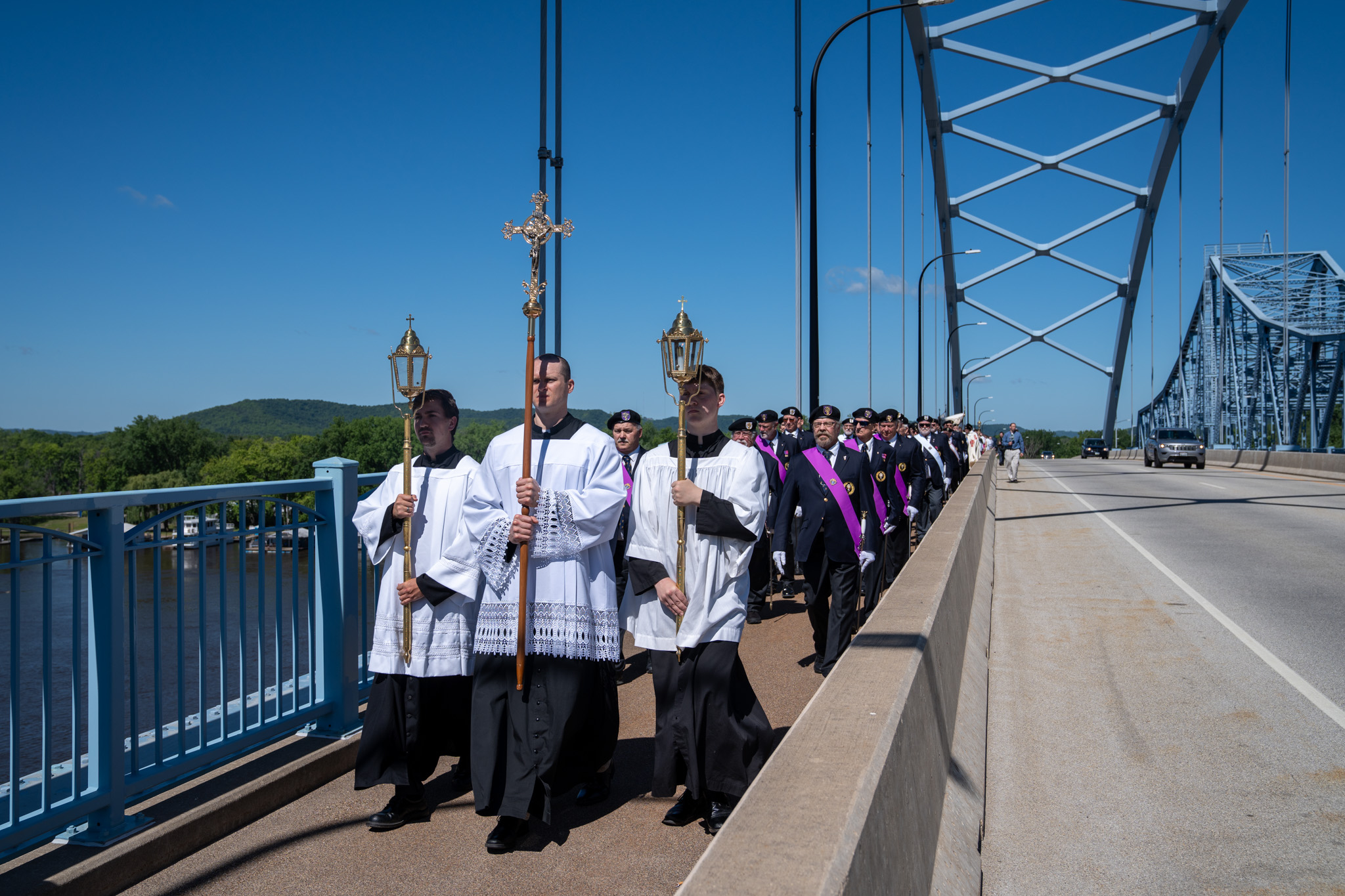Day 1: ‘The Answer’
“Answering His Call”
More than 3,000 men and women—families, clergy, religious and laity from across the Midwest converged in the La Crosse Center on June 7 to celebrate the Eucharist and welcome Jesus to the Diocese of La Crosse as He traveled from the headwaters of the Mississippi River, along the Marian Route of the National Eucharistic Pilgrimage, to the 10th National Eucharistic Congress.
Thousands of people streamed into the La Crosse Center after processing with Jesus across the Mississippi River. The Diocese of La Crosse’s eucharistic rally, “the ANSWER,” then began with a welcome and celebration of the Mass. But the planning for the rally started many months earlier.
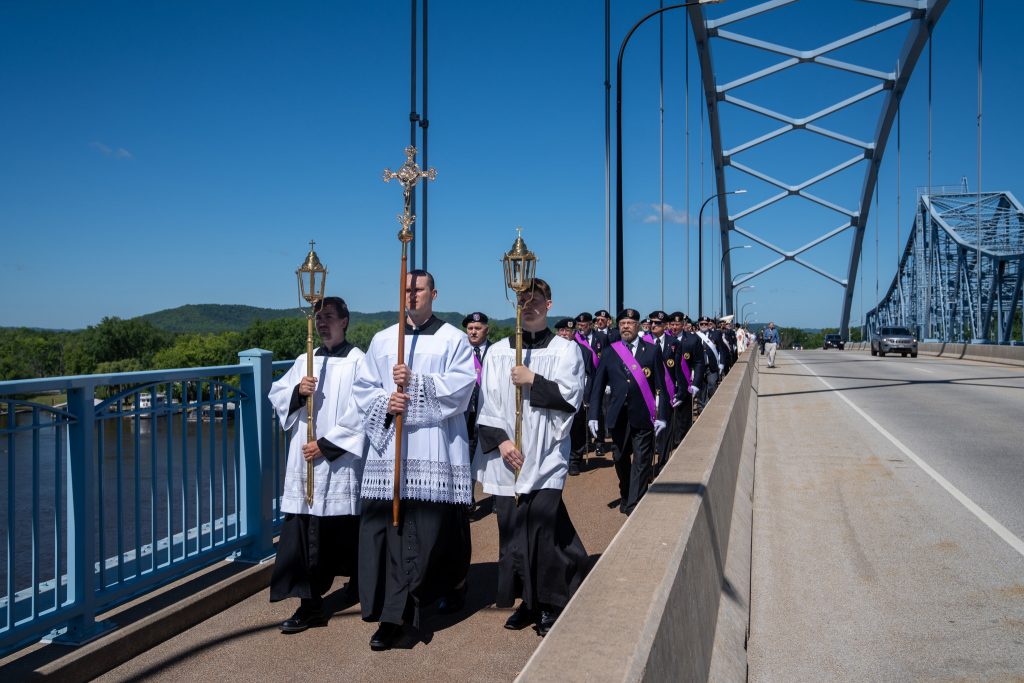
Country Roads
The axiom in the diocese is that whenever asked how far away something is, the answer is always “about two hours.” It was on one of these two-hour(ish) drives that Chris Rogers, the diocesan director of family life and youth ministry, recalled how often adults wistfully approached him and wished there was an event for adults that evoked the energy and excitement they felt as kids when attending Adventure Camp. The Holy Spirit’s hand guided those rural roads, and Chris decided to explore hosting an adult event. Familiar steps followed as he researched a venue and began coordinating speakers.
Indeed, the event’s theme quickly became apparent. In the middle of the National Eucharistic Revival and with the momentous National Eucharistic Congress approaching next year, Chris decided to focus the event on the Eucharist. The next step? The event needed a title. Amid many ideas, thoughts and considerations, one realization became clear—the ascendency of a culture that celebrates self before all—a culture that guides restless hearts toward wealth, power, pleasure and honor—creates confusion and division.

While the problem seems complex, the resolution is not. To every question, Jesus is the answer. The Lord answers every question, offers us stillness and refuge and invites us to His table for breakfast. He is our answer. In retrospect, the path was straight, but when Chris decided to name the rally “the ANSWER,” the next steps were anything but known. Very few steps from this point forward followed that familiar path.
The Pilgrimage Comes
More steps on the Holy Spirit’s blazed path for the Diocese of La Crosse became clear when the National Eucharistic Revival team contacted Bishop Callahan and inquired if the Diocese of La Crosse would like to participate in the National Eucharistic Procession’s Marian Route as it traveled from the headwaters of the Mississippi to the National Eucharistic Congress in Indianapolis. Stirred by the revival and the opportunity to host Jesus in His journey, Bishop Callahan agreed and appointed his executive assistant, Debbie Brannon, to spearhead the diocesan effort. The chance to enflame the hearts of people across the diocese’s 19 counties was at the forefront of her mind, and with the same fervent prayer, the Holy Spirit led her to the same destination as Chris—hosting an event that would draw as many people as possible to a celebration of Jesus and the Eucharist.
Teams Form and Paths Clear
The planning began in earnest, and curia staff and leaders from across the diocese were called on to join the effort and together. Providentially, the only location large enough to host an event of the size envisioned, the La Crosse Center, was available on the only two days that would work for the Diocese of La Crosse—June 6 and June 7. Putting the plan in the Holy Spirit’s hands, the lead co-planners acted boldly. They asked three of the most powerful Catholic speakers to travel to the La Crosse Center for the eucharistic rally and, despite the odds, all three were available to speak at the rally on the specified date.
The Holy Spirit continued to burn a clear path before the co-lead planners, and the musicians they invited were also available and eager to join the celebration.
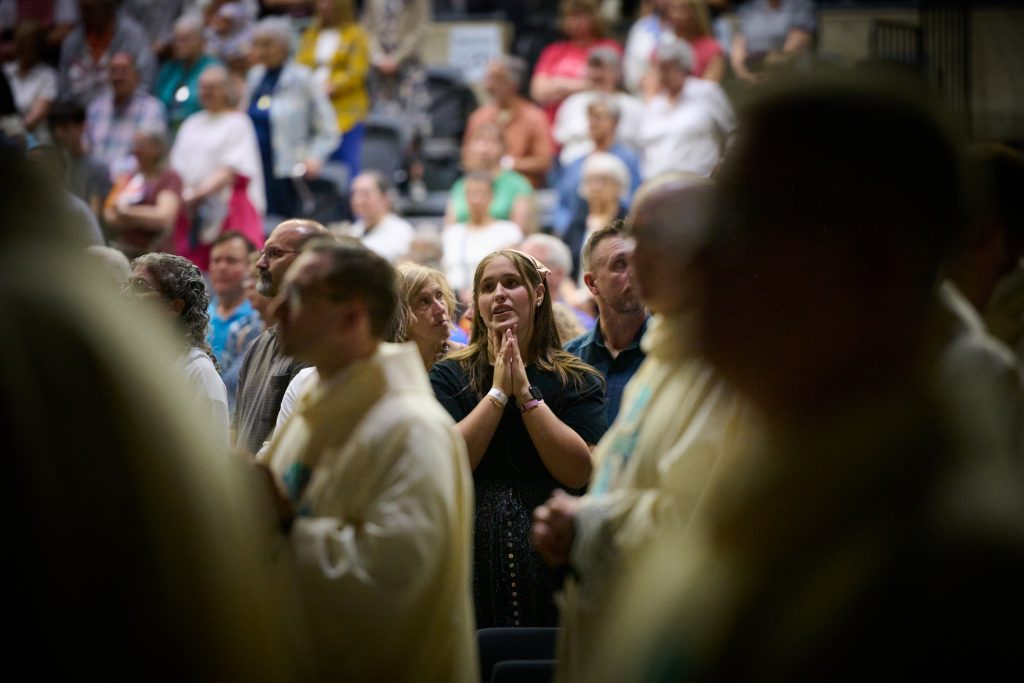
As more people joined the planning effort, the team grew in size, joy and capability as a group united by their gifts.
Planning was matched by efforts. People from Wisconsin, Minnesota, Iowa, Illinois and beyond traveled by foot, vehicle, bus and airplane to attend the eucharistic rally and encounter Christ. These men, women, families, children, clergy and religious joined the Diocese of Winona-Rochester and together they processed our Lord across the Cameron Street Bridge. Stopping at the midpoint of the bridge high above the mighty Mississippi, the Most Reverend Robert Barron, the bishop of the Diocese of Winona-Rochester, raised high the monstrance and blessed the people of Minnesota and the river beneath him. He then turned to bless the people of Wisconsin.
Bishop Battersby and the Diocese of La Crosse then processed into the La Crosse Center with more than 1,000 people. So many people walked with Jesus that many faithful had crossed the Mississippi while others were still on the other side of the river.
All converged for the eucharistic rally. A year in the works of human hands, Jesus processed into the arena and people celebrated Mass, adored our Lord, listened to inspired music and speakers and encountered Christ in intimate and powerful moments.
“the ANSWER” is Jesus. He is calling you. Are you answering Him?
Day 2: St. Rose Convent and The Shrine
Adoration and Our Blessed Mother
Alight with the Holy Spirit and enflamed in their encounters with Christ, the thousands of people who attended the National Eucharistic Pilgrimage’s procession across the Mississippi River and then celebrated the eucharistic rally in the La Crosse Center stepped into the evening air knowing that the rally didn’t mark a conclusion but was, instead, a beginning.
Similarly, the procession and eucharistic rally on day 1 marked only the beginning of the National Eucharistic Pilgrimage’s journey through the Diocese of La Crosse. The first day was characterized by the fire and wind of the Holy Spirit, which swept people together in celebration, music, testimonials and an electrifying and historic gathering, while the second day provided the stillness, reflection and adoration unique to Mary of the Angels Chapel and the Shrine of Our Lady of Guadalupe.
Perpetual Adoration
Mary of the Angels Chapel, located within St. Rose Convent in La Crosse, is the home of the Franciscan Sisters of Perpetual Adoration (FSPA). The chapel, consecrated in 1906, is known for its Bavarian stained glass, Romanesque architecture, Corinthian-style pillars and its perpetual adoration chapel. The sisters have been praying before the Blessed Sacrament without interruption since Aug. 1, 1878.
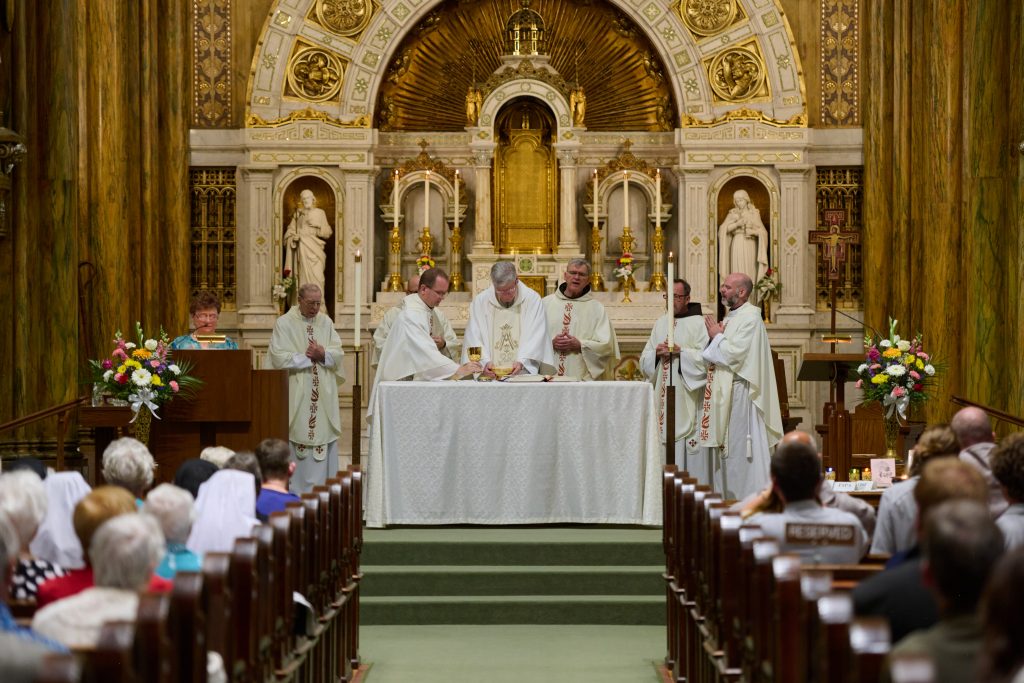
Sister Sue Ernster, the FSPA president, and her fellow sisters welcomed the perpetual pilgrims with their hallmark warmth and hospitality before leading a tour of the convent and chapels. Sister Laura Nettles also shared the compelling life and journey of fellow Franciscan Sister of Perpetual Adoration, Servant of God Sister Thea Bowman.
The chapel, adorned with fresh flowers and glowing candles, stood as a testament to the unwavering devotion that has defined this sacred space for generations.
One of many highlights was visiting the perpetual adoration chapel and the moments spent in eucharistic adoration, a time of deep prayer and contemplation before the Blessed Sacrament. As the pilgrims knelt in silence, the chapel radiated holiness and seemed to breathe with the presence of the hundreds of sisters who together have spent nearly 150 years adoring Christ in that exact location.
Following the adoration, Bishop Gerard Battersby celebrated a special Mass, bringing together the pilgrims, the Franciscan Sisters, and the local faithful in the Eucharist.
Patroness of the Americas and the Unborn
Departing from St. Rose Convent, the National Eucharistic Pilgrimage team headed south along the Mississippi River and toward the serene bluffs and farmland south of La Crosse. Situated on 100 acres in these bluffs, the Shrine of Our Lady of Guadalupe was dedicated in 2008 to Our Lady of Guadalupe, the Patroness of the Americas.

The Shrine serves as a pilgrimage site where the faithful can experience Mary’s maternal care and deepen their relationship with her Son, Jesus Christ.
Father Paul Check, the Shrine’s Executive Director embraced the pilgrims as they arrived. The Shrine’s beauty and tranquility provided a perfect backdrop for the National Eucharistic Pilgrimage’s afternoon stop on day two. Perpetual pilgrims brought forth the Blessed Sacrament, and the assembled faithful processed up the meditation trail to the Shrine Church.
Opportunities for confession and adoration followed Father Check’s remarks. The sacrament of penance and gazing at our Lord in adoration are central within our faith, and the opportunity to participate in them within such a sacred setting and with the National Eucharistic Pilgrimage present provided a profound encounter with Jesus.Day two of the National Eucharistic Pilgrimage’s path through the Diocese of La Crosse was one of profound peace, quiet and holiness—a place of refuge in a chaotic and restless world.
Day 3: St. Patrick and Ss. Peter and Paul
A Tapestry of Our Faith
“God dwells in our midst, in the Blessed Sacrament of the altar.” —Saint Maximilian Kolbe
The previous two days in the National Eucharistic Pilgrimage’s journey through the Diocese of La Crosse were marked by thousands of people gathering from across the Midwest in the La Crosse Center for a historic eucharistic rally, a soaring Mass in Mary of the Angels Chapel with the Franciscan Sisters of Perpetual Adoration and a eucharistic procession, confession and adoration at the Shrine of our Lady of Guadalupe.
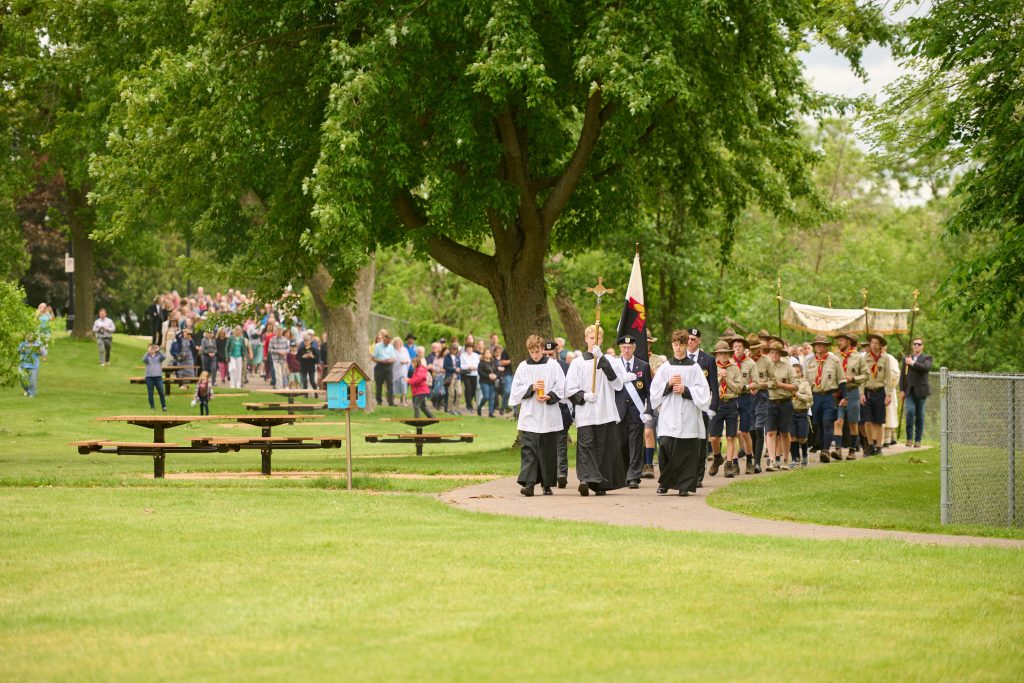
On the third day, Jesus departed La Crosse and toward the essence of the Diocese of La Crosse—farmland.
Spanish Mass in Sparta
Only a stray puff of a white cloud disturbed a vast sea of dark green corn and the azure sky overhead. Down a dusty gravel road and tucked within these cornfields, hundreds of parishioners from St. Patrick Parish in Sparta eagerly awaited the National Eucharistic Pilgrimage for its next stop toward Indianapolis and the National Eucharistic Congress.
White porch and rail fencing pushed back against the field of cornstalks while the musicians prepared to help celebrate Mass. Their peaceful and joyous efforts in these final moments were the culmination of months of planning. The predominantly Hispanic community planned a vibrant outdoor Mass, a eucharistic procession with several altar stops and a breaking of bread to conclude.
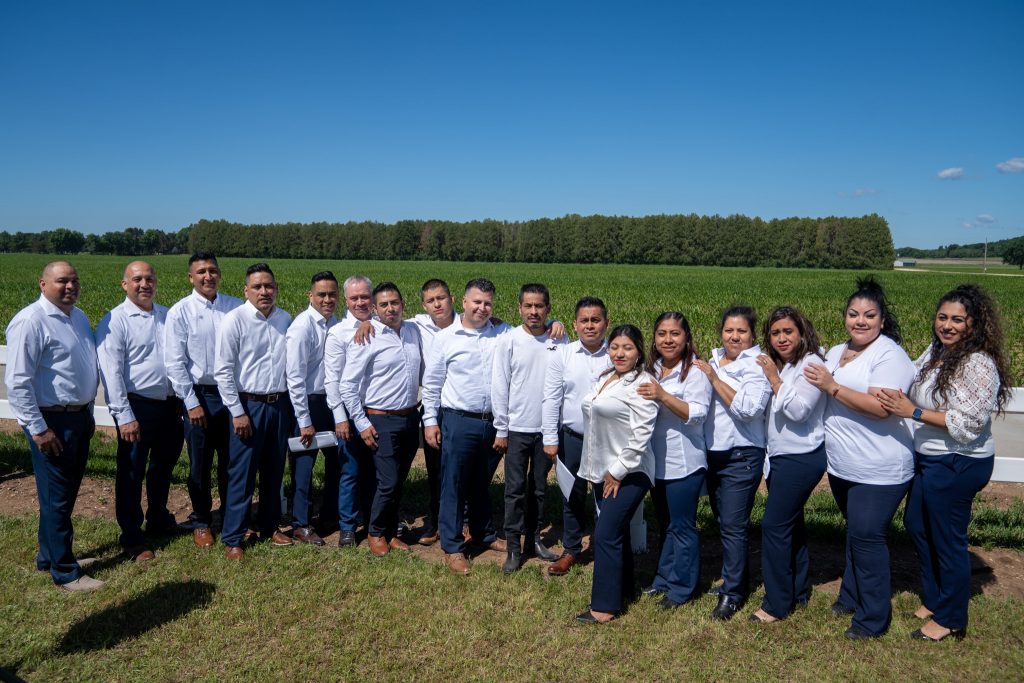
Anticipation was high as the National Eucharistic Pilgrimage and the perpetual pilgrims arrived. A wave of stillness and peace washed over the hundreds present as pilgrims emerged with the Blessed Sacrament in the monstrance. Dropping to their knees and tucking their chins to their chests, the St. Patrick community welcomed our Lord with reverence.
Reverence exists both in quiet prayer and in vibrant celebration, and the gathering rapidly transitioned from the former to the latter. A group of 15 musicians, united in song and worship, signaled the congregation to stand as Mass began. Most Reverend Mark Bartosic, an auxiliary bishop with the Archdiocese of Chicago celebrated the Spanish Mass and was joined by Father Eric Berns, Father Fernando Lara-Hernandez and Father Woodrow “Woody” Pace.
Once Mass concluded, Father Fernando placed the Blessed Sacrament in the monstrance and led the eucharistic caravan, and the many gathered parishioners, through prayer and song at several altar stops. The solemn and elegant movements of the eucharistic caravan were not the characteristics one could use to describe the flurry of movement only 100 feet away as many hands prepared a bounty of traditional Hispanic food for the lunch that would shortly follow.
The final altar stop and blessing finished and, overflowing with spiritual nourishment, the group turned toward the fellowship and the welcoming aromas of horchata, tacos and traditional foods.
Ss. Peter and Paul in Wisconsin Rapids
The sky welcoming the National Eucharistic Pilgrimage in Wisconsin was decidedly less serene. And yet, as one attendee noted, “It’s so beautiful to see all these people gathered together to worship our Lord. It’s very inspiring to see that on a windy evening, it matters enough for people to come out.”
Hundreds gathered together at Mead Rapids View Park to greet Jesus as He arrived from Sparta. Despite geographical differences and unique aspects of beauty resident to each stop that day, the same stillness, reverence and awe greeted our Lord as He emerged in the monstrance.
After donning a humeral veil, Father Schaller grasped the monstrance, slowly and solemnly faced each cardinal direction and blessed the city and its nearly 20,000 residents. Led by the Federation of North American explorers, the procession walked alongside the Wisconsin River toward Ss. Peter and Paul and they sang hymns and prayed the rosary. People on the other side of the street fell to their knees as the Blessed Sacrament passed by.The procession then entered Ss. Peter and Paul and Father Schaller celebrated Mass before the evening concluded with a potluck dinner.
Day 3 of the National Eucharistic Pilgrimage could be seen as a study in contrast between paved and gravel roads, blue skies and gray clouds and music expressed through an angelic choir and a lively band. And yet, these rich textures and contours of faith could not be more closely united in the via pulchritudinis, “way of beauty” toward Jesus Christ.
Day 4: St. John the Baptist
Celebrating Blessed Brother James Miller
I was late. The National Eucharistic Procession was set to appear at the graveside of Blessed Brother James Miller in 90 minutes, and I was 100 minutes away, according to Google. The grave was somewhere near Polonia, about two miles from Sacred Heart Church. I didn’t have time to search—I just got in my car and headed east. As I drove, I wondered where one would bury a venerable Catholic martyr in the middle of rural Wisconsin. But after a little thought and prayer, I could see it in my mind as clear as day.
I knew exactly where to find Blessed Brother Miller.

More than 20 years ago, my young family and I lived in Polonia while I worked at the nearby university. Every day, on the way to work, I would drive by the little white church of St. Martin, nestled among the crop fields of Central Wisconsin, lovingly maintained but no longer in use. Behind the church is a neatly arranged churchyard with about 200 graves. There, beneath a modest granite headstone, lies the body of Blessed Brother James Miller.
I arrived at St. Martin Church at exactly 9:30 a.m. More than 200 people had gathered to honor Blessed Brother Miller and adore the Blessed Sacrament. A processional banner with a portrait of Hermano Santiago, as he was known to his Latin American students, stood behind the gravestone. There was a small table with a white tablecloth and two candles ready to receive the monstrance. A group of fellow De La Salle Brothers was also present to honor their fallen brother. On that beautiful summer morning, under a bright, cloudless sky, we sang the O Salutaris Hostia and recited the Divine Praises before the Blessed Sacrament.
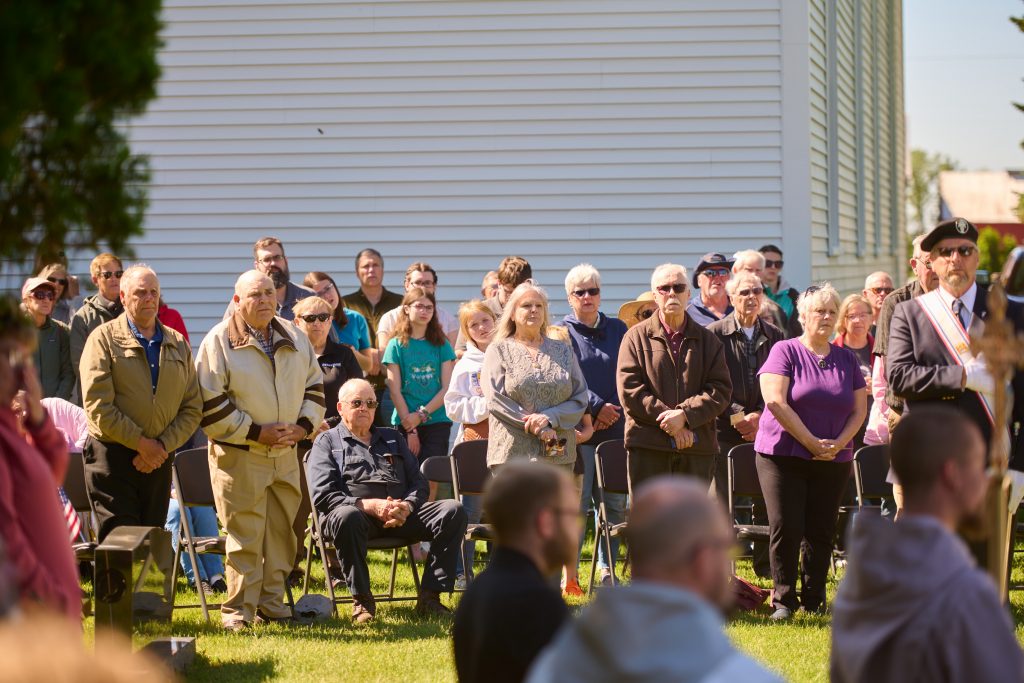
The most amazing thing about gathering around the grave of this holy man was the immediacy of his presence. This wasn’t a man who died centuries ago, but rather a man whose life overlapped my own. His brothers, Bill and Ralph, now elderly gentlemen, and his sisters, Pat and Louise, stood mere feet from me. The family still operates the farm where Brother James grew up. It is right across the road from the cemetery. One of the speakers was Brother Stephen Markham, FSC, a classmate and good friend of Brother James. Brother Markham helped with the funeral preparations after Brother James was martyred in Guatemala in 1982. Brother James may be in heaven, but his memory still lives in those who walked the earth with him.

A Day to Remember
After the ceremony, I returned to my car to follow the procession to St. John the Baptist Church in Marshfield. The beautiful weather held, and by 2 p.m. a group of several hundred adorers began the three-mile Eucharistic Procession along Veterans Memorial Highway in Marshfield. As we walked along the procession route, the line was too long for all of us to sing in unison, but spontaneous hymns broke out here and there along the line. At each stop, we read from Scripture and observed a moment of silence. It was a truly joyful experience for all involved. The city officers who helped with traffic control grinned from ear to ear as they were thanked by nearly every person who passed by.
That afternoon, I saw the Eucharistic Miracle exhibit of Blessed Carlo Acutis, which was on display in the gym of St. John the Baptist School. In the basement, there was a display promoting the many missions supported by the parishioners of our diocese. I thought of Father Joe Walijewski and Blessed Brother James Miller, two members of our diocese who exemplified the missionary spirit in Latin America.
Later that evening, we gathered in St. John the Baptist Church to hear about these two holy men. Father Alan Guanella spoke about Blessed Brother James, having been pastor at Sacred Heart Parish in Polonia at the time of Brother James’ veneration in 2019. We had a few moments to pray before a first-class relic of Brother James, a lock of his hair. Then Father Woody Pace, vicar for clergy, gave a presentation—more of a sermon, in fact—on the life of Father Joe Walijewski. Both pastors did an excellent job of conveying the deep Christian love that Brother James and Father Joe showed to the people of Latin America.
A Familiar Story
When I was a student at St. Mary’s University in the late ’80s and early ’90s, the Christian Brothers often spoke fondly of Brother James. Some of them had known him during his formation years at St. Mary’s in the 1960s. After his martyrdom in 1982, everyone expected that his cause for canonization would eventually succeed. However, the road to sainthood is a long one. As I graduated and moved on to other things, I thought less and less about Brother James over the years.
As I sat and listened to Father Guanella describe the short, powerful life of Brother James, I found connections with my own story at every turn. Brother James grew up on a farm near Stevens Point near where I would eventually live almost 50 years later. He attended Pacelli High School in Stevens Point, then St. Mary’s University in Winona, Minn., my alma mater. He took his first vows as a Christian Brother in 1963, and his final, permanent vows in 1969. In 1980, two years before his death, he spent time at the Sangre De Cristo Renewal Center in New Mexico discerning a possible call to the priesthood. My wife is from New Mexico, and I had lived there for many years. Brother James was a teacher of Spanish at Cretin High School in St. Paul (now Cretin-Durham Hall High School) but felt the call to teach in the schools of Nicaragua and Guatemala. I, too, had taught students in a foreign language in a Third-World country.
But unlike Brother James, I have never been threatened by Sandinista death squads, and when that threat materialized in 1979, Brother James was transferred back to the United States for his own safety. He spent some time back at Cretin High School, but the sense of mission he felt for the people of Latin America was too strong. He requested and received a transfer to Huehuetenango, Guatemala in 1981, and in one of his last letters, he wrote, “I pray to God for the grace and strength to serve Him faithfully among the poor and oppressed in Guatemala. I place my life in His providence. I place my trust in Him.” On Feb. 13, 1982, he was gunned down while repairing a wall. His killers were never caught, but they are thought to have been agents of the government, which objected to the Christian Brothers’ efforts to prevent young students from being conscripted into the military.
A Friend in Heaven
Blessed Brother James Miller weighed heavily on my mind. As I sat on the edge of the bed, I shared with my wife the deep connection I felt with this man whom I had never met. He seemed like someone I had just narrowly missed encountering, but whose presence could still be felt in the room.
“You should make him your friend,” she suggested.
I smiled at that. I should indeed, as should we all! I think my friend, Blessed Brother James Miller, was pleased to see this beautiful procession pass through the beloved farmlands where he first encountered Christ in the Eucharist.
Day 5: St. Bernard; Mary, Mother of Good Help and Holy Name
Christ is the Common Bond
The fifth day of the National Eucharistic Pilgrimage’s journey through the Diocese of La Crosse aimed to unite Jesus and diverse communities.
The day began with a 7 a.m. Mass at St. John the Baptist Church in Marshfield. The Blessed Sacrament was then transported to St. Mary Help of Christians Church in Colby, where pilgrims gathered for the longest procession of the Blessed Sacrament in our diocese—4.3 miles from St. Mary’s to St. Bernard Church in Abbotsford.
Led and followed by the Colby-Abbotsford Police Department, more than 100 pilgrims journeyed through the city streets of Colby singing songs, saying prayers and praising Jesus in both Spanish and English. The eucharistic procession caught the attention of many residents, who came out of their homes to see what was happening, only to be met with voices proclaiming, A ti, oh Dios, te alabamos, a ti, Señor, te reconocemos. “You are God: We praise you; You are the Lord: we acclaim you.”
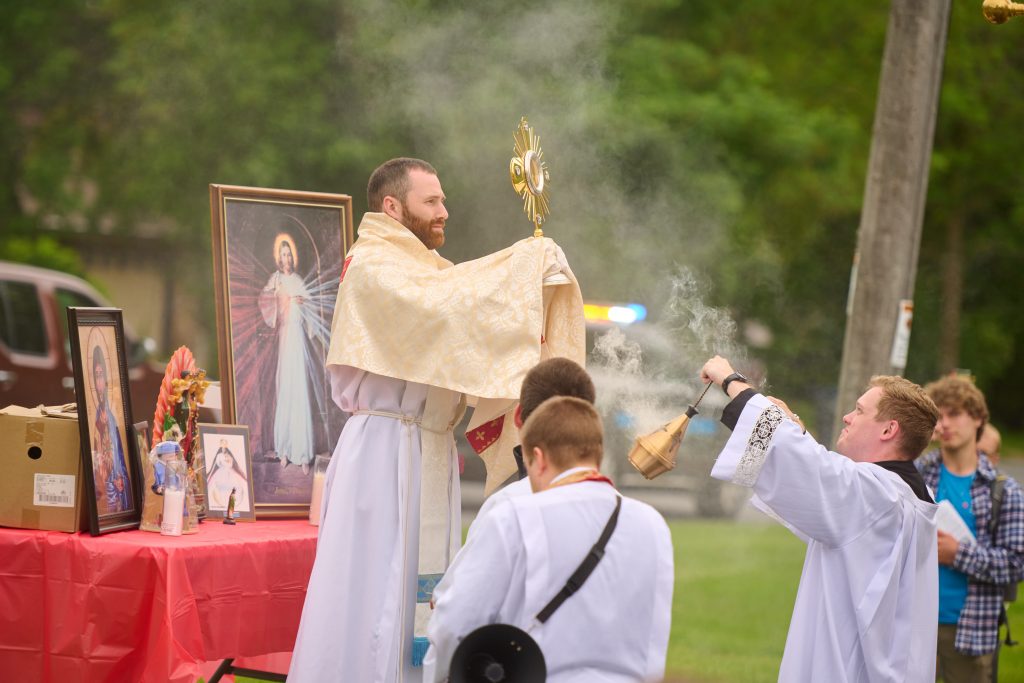
The pilgrimage worked its way out of Colby and into the countryside—a sharp contrast to the previous day’s route, which was predominantly along busy city streets. As they passed through the agricultural landscape of central Wisconsin, they were greeted by livestock and the occasional John Deere tractor.
After approximately 2.5 hours, the pilgrims arrived at St. Bernard Church in Abbotsford, which has a large Hispanic community in the parish.
“St. Bernard’s is currently 70% to 80% Spanish,” explained Father Tim Oudenhoven, the parish’s pastor at the time of the procession. “We have multiple cultures, and we also have a growing Vietnamese community. The Hispanic culture is very diverse, with people from all over, such as America, South America and Mexico. It’s truly a lot of fun.”
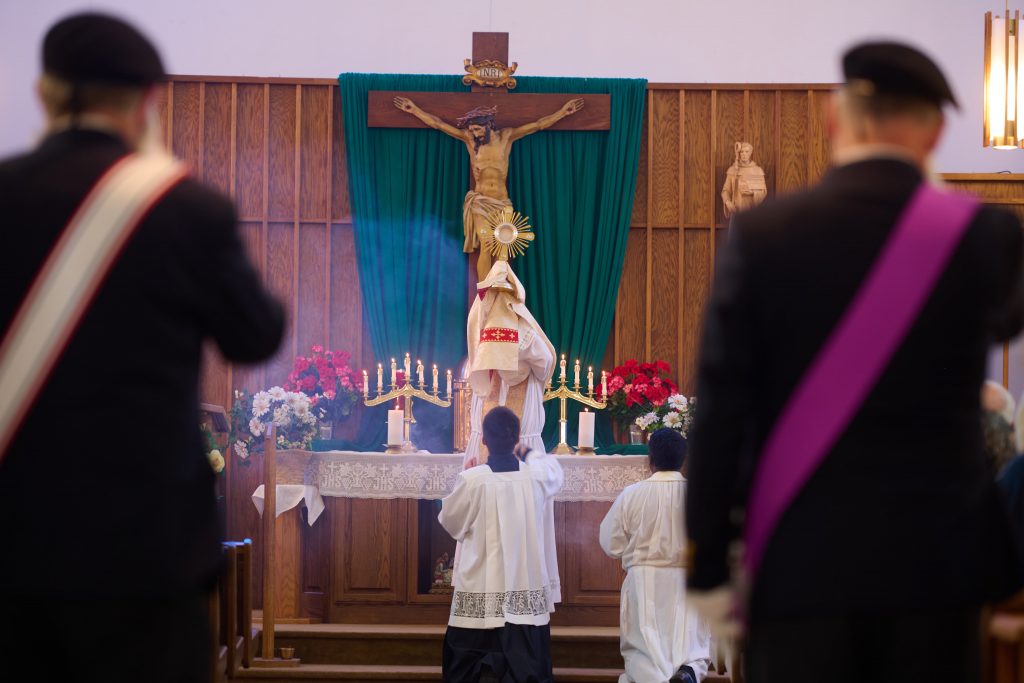
When the pilgrims arrived at St. Bernard’s, they spent time with Jesus in adoration and enjoyed a lunch consisting of burritos, flautas, salads and more.
Parishioner Miriam Fuentes said it was an honor to have pilgrims from Wisconsin and beyond come to visit their parish. Showcasing their culture was a big part of the day.
“It is important to show our culture because we are three communities together: The Vietnamese, Hispanic and American communities. Together, they all form a big community. Everybody came and adored God. No matter our culture, we are here for the same thing: to adore God,” Miriam explained.
That common purpose was displayed throughout the day, with prayers and liturgies proclaimed in English and Spanish. Even those who don’t regularly speak Spanish did their best to follow along during those portions of the prayers.
From there, the procession traveled eastward to Wausau and Mary, Mother of Good Help Church—the only Hmong Catholic church in the country.
Coming to Know Christ
Father Al Burkhardt said the day was particularly special for his flock as they continue their personal journey of knowing and loving Christ in the Eucharist.
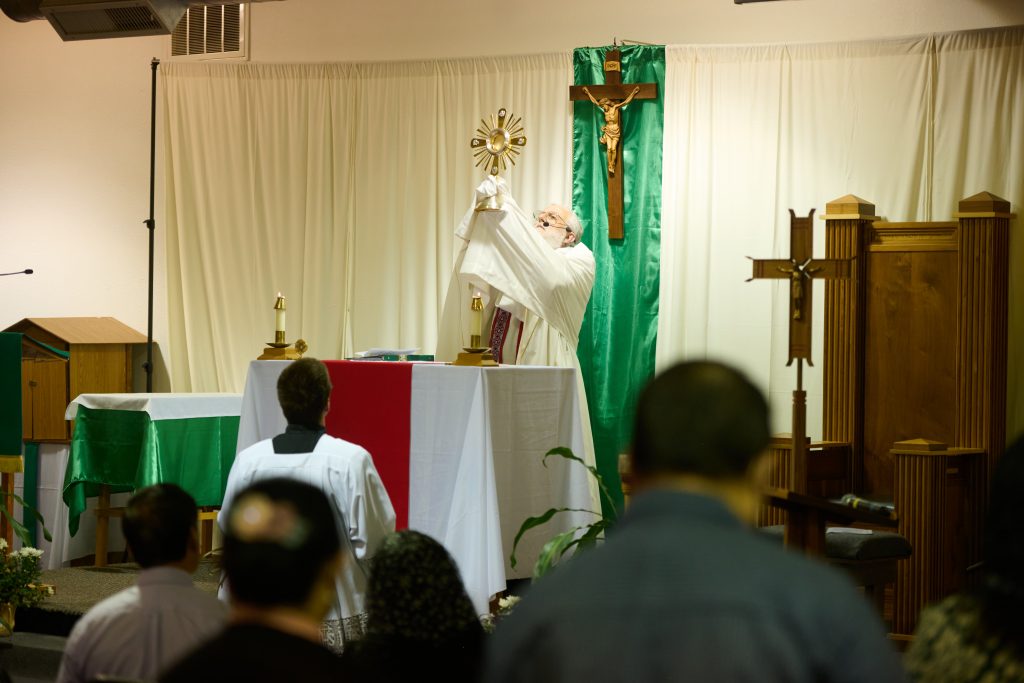
“For the Hmong people, the Eucharist is a very new concept. Today, it serves as a way for them to learn about Jesus, understand the significance of the cross, death and resurrection, and see how God’s love for them is manifested through these. The connection of Jesus in the Eucharist is the glue that holds us together and keeps us as one.”
For Xiong and Ying Lo, the day was a new and profound experience, leaving Ying overcome with emotion as he explained what he had experienced.
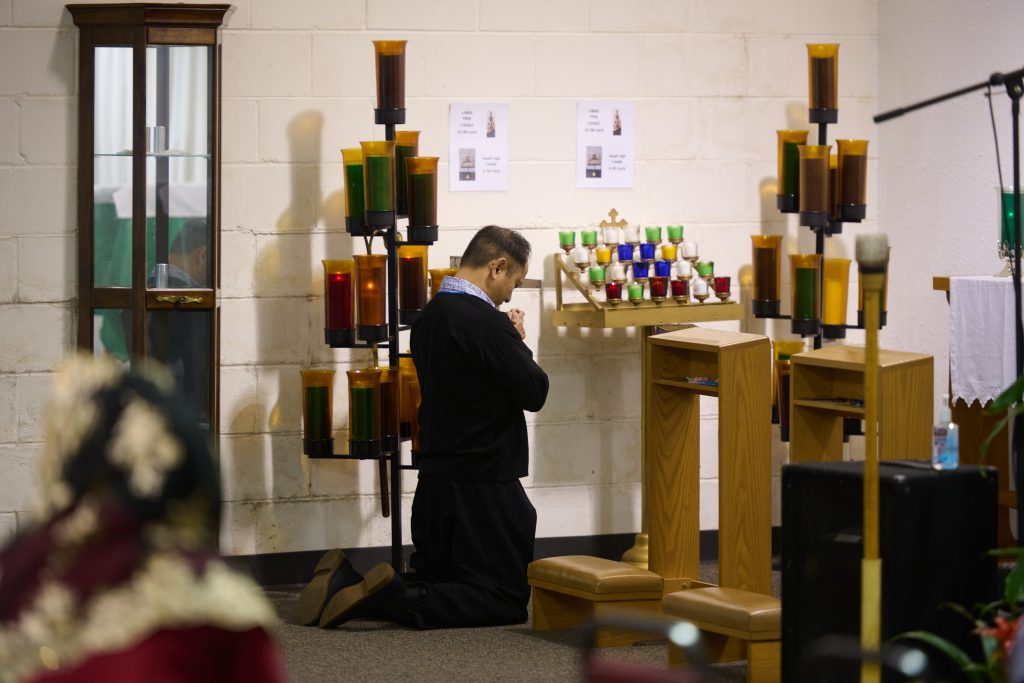
“I feel that Jesus is with me, and He actually came to my heart,” Ying shared, pausing to collect his emotions. “I feel very strongly that He connected to us.”
“It’s a super special moment for me. It’s my first time attending one of these special events. It really brings such a calming feeling, and I feel that the Holy Spirit is here with me. It’s just been really great. I feel like He visited me here. I was shaking when Jesus came into the church,” Xiong professed.
After enjoying an authentic Hmong meal, the pilgrims of the National Eucharistic Procession spent the evening at Holy Name of Jesus Church for prayer, confession, adoration and socializing.
Day 6: St. Matthew
Central Wisconsin Hispanic Youth Follow Jesus in the Eucharistic Procession
On Wednesday, June 12, at 8:30 a.m., the St. Matthew’s Church parking lot was beginning to come alive. A pair of young adult leaders donning matching gray-blue T-shirts emblazoned with the word “CHAMPION” were waiting on the entrance steps. A white club van with a graphic of a monstrance and host and the words “Eucharistic Procession” pulled into the parking lot. The leaders, carrying their sizable backpacks, got up and made their way to the vehicle. Like the apostles, they were following Jesus.
Wearing the Face of Jesus
Inside the church, the gathering space felt like an ordinary, a quiet midweek morning. As the 8 a.m. Mass was wrapping up, a few families were outside, busily unloading bottled water and bagged lunches in anticipation of the day’s activities. Then, two yellow school buses arrived carrying about 200 Hispanic youth on retreat. Father Tim Oudenhoven of Abbotsford led the flock of youth, aged elementary through high school, into the gathering space. In his boisterous and booming voice, Father Tim invited the kids to gather around and have a seat on the floor. His enthusiasm revealed an infectious joy and excitement for the youth and this procession. He explained that everyone here will have a very unique opportunity to follow the real presence of Christ in the Eucharist. This special group wore matching yellow T-shirts with a black outline of Jesus’s sorrowful face wearing a crown of thorns. Father Tim explained that the reason for that particular depiction is because it represents Jesus in la hostia, “the host.”
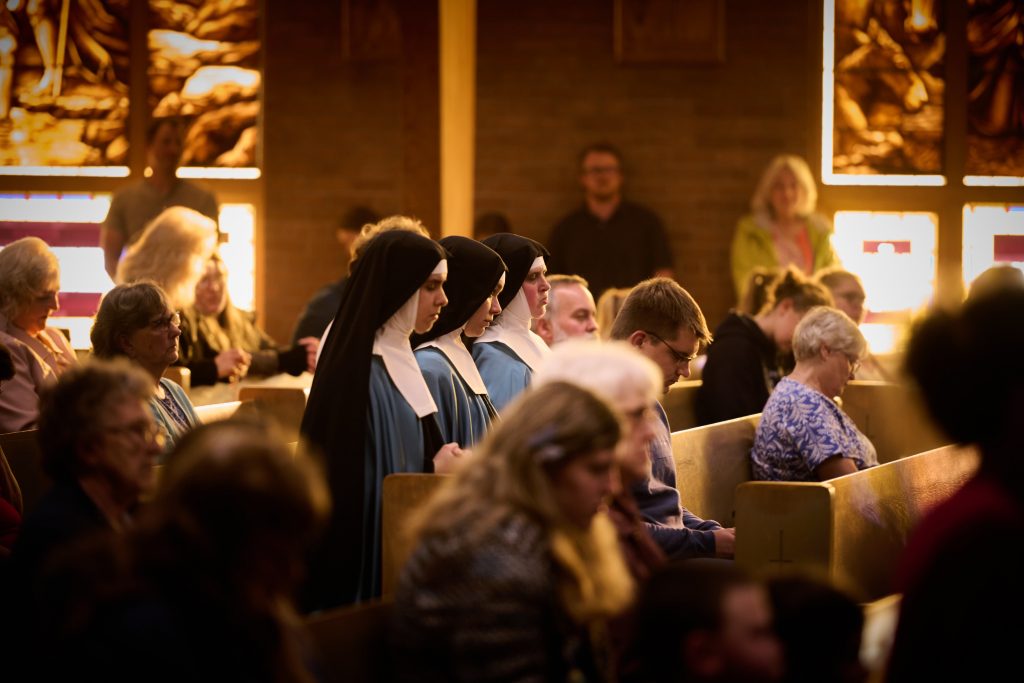
Mass = Authentic Love
During Mass, all the youth were seated in front and listened to the Introductory Rites and Liturgy of the Word in Spanish. Then Father Tim gave a wonderful homily in English, recounting the first reading about Elijah and the sacrifice challenge to false gods. He shared a personal childhood story in which his young cousin tested the love of his father. Father Tim explained that we sometimes tend to do things, similar to his young cousin, to see if there really is a God or if God really loves us.
However, a loving parent tells their child that to find out if they are loved, all they have to do is ask. They don’t have to invoke a test or experiment; just ask! That is what God the Father is for us: a loving Father who is present unconditionally; all we need to do is ask. Father Tim expressed his concerns about social media and cautioned the youth about what they seek and view on popular video sites and chat apps. He warned that we should not seek out or view temptations of evil. He invited the youth to put away social media and instead seek authentic love in Jesus.
Going Forth, Following Jesus
After the celebration of Mass, there was a short exposition and benediction. Then, everyone respectfully filed back into the gathering space to enjoy the bagged lunch and snacks. After more quiet time in adoration in the church, the youth followed the monstrance out to the club-van motorcade where the Eucharist is held for traveling. The group boarded the buses and followed the eucharistic procession to their next stop in Wittenberg, a small town along Highway 29 East, where they would follow Jesus into the next parish and meet up with another youth group. The procession would continue to the next stop on the Marian Route, the Shrine of Our Lady of Good Help in Champion, near Green Bay.
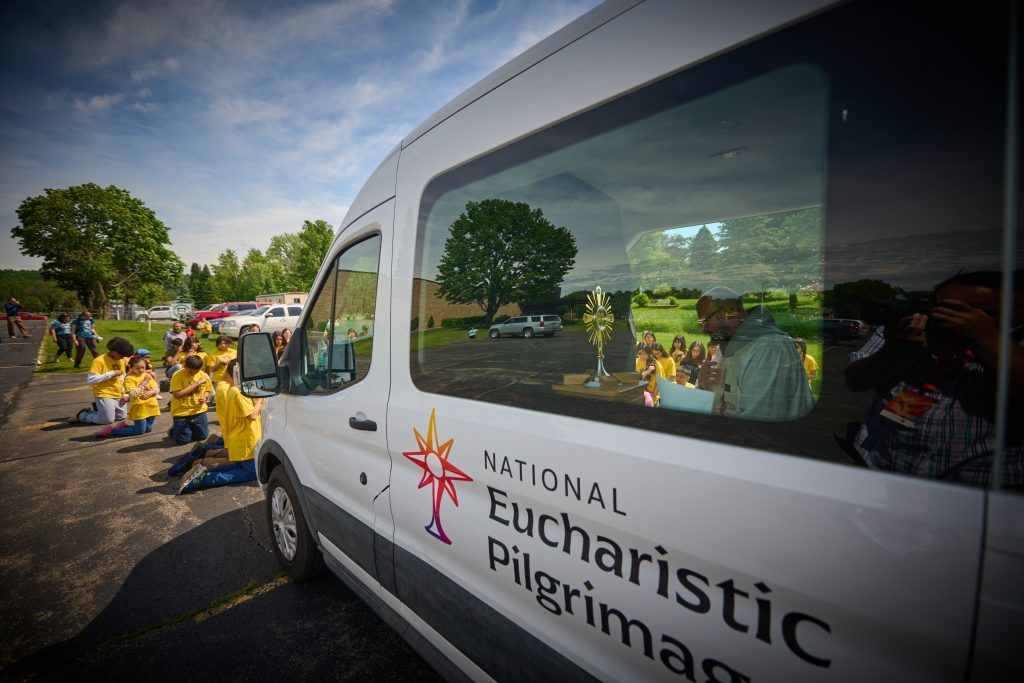
Through the intercession of the Holy Spirit, let us pray that the seeds scattered throughout this procession find fertile ground and are sown to become future disciples.

